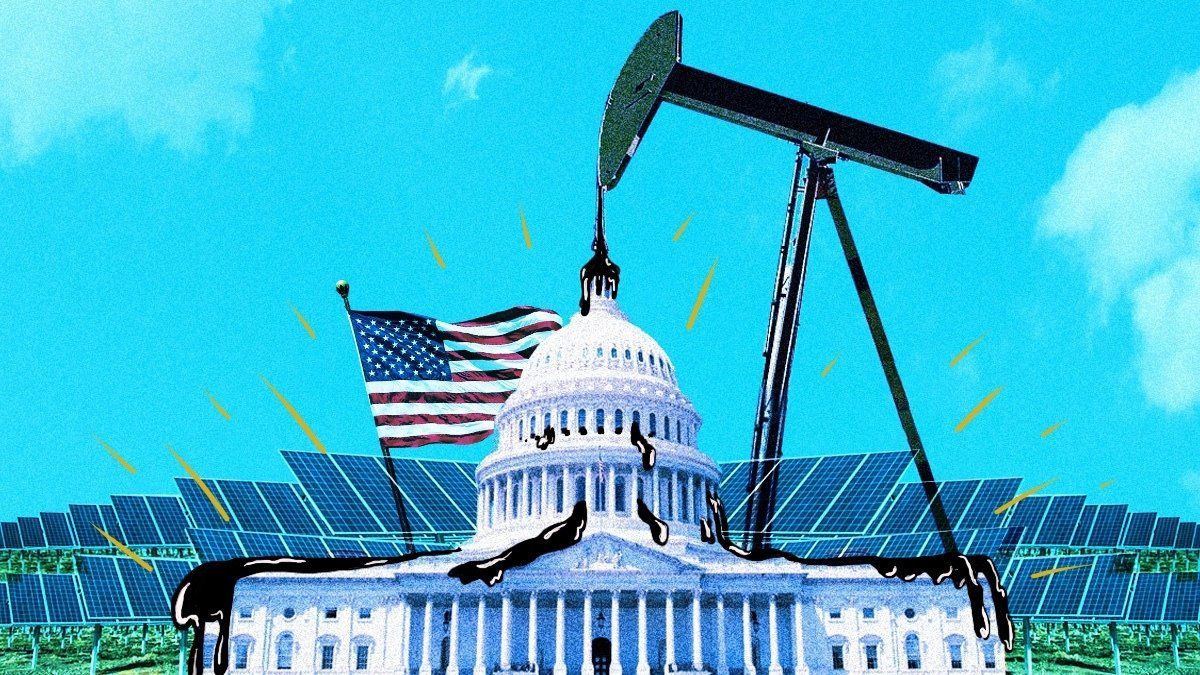“A few years ago, we were energy independent, now we’re begging countries to give us gasoline.” —Former president Donald Trump
“Joe Biden has destroyed US energy independence.” —Sen. Marsha Blackburn (R-TN)
“Since Joe Biden’s first day in office, he has waged an unprecedented war on American energy producers.” —House GOP
If we are to believe Republican politicians, President Joe Biden is waging a debilitating “war” on American energy. But is that true?
Not quite. After having to import massive amounts of foreign energy for most of its modern history, the United States became energy independent in 2019 – when Donald Trump happened to be president – thanks to the decades-long fracking and shale revolution. Domestic oil and gas production dipped briefly during the pandemic as global demand collapsed, but it quickly bounced back under President Biden.
Today, the US is the largest crude producer in the world by a mile, pumping out over 13 million barrels per day and accounting for nearly a fifth of the world’s total oil production. Indeed, the US is now producing more oil than any country in history.
A similar story can be told for US natural gas production, which has also been setting record highs since recovering from the pandemic in 2021. As of 2022, the US exported far more natural gas than it imported – the bulk of which has been converted to liquified natural gas (LNG) and gone to Europe to ease the energy shortage created by the cutoff of Russian supplies in the wake of Vladimir Putin’s invasion of Ukraine. Last year, the US overtook Australia and Qatar as the world’s largest exporter of LNG, and the country’s export capacity is only set to continue growing.
Meanwhile, the US continues to deploy renewables, such as solar power and battery storage, at a significant rate. Together, these sources are expected to make up 81% of all new electric-generating capacity in the country this year. Such growth is in large part thanks to the exponential decline in the cost of these technologies, whose uniquely steep learning curves suggest they are going to get even cheaper as they get deployed further, in turn boosting adoption, getting more competitive, and so forth.
In short, the US has quietly but surely become the world’s top energy superpower. As Sen. Joe Manchin (D-WV) put it in a recent op-ed, “our country has never been more energy-independent than we are today.” Much like America’s hegemony in other realms, this newfound dominance does not come without certain geopolitical upsides.
For starters, America’s large and growing market share deprives Russia, Saudi Arabia, Iran, and other petrostates of both pricing power and geopolitical leverage, lowering energy prices and boosting geopolitical stability. This was evident in the aftermath of Russia’s invasion of Ukraine, when US energy exports played a major role in stabilizing global energy markets and bolstering European energy security. US oil supply growth has also kept oil prices relatively in check in the face of OPEC production cuts designed to prop them up.
Even with the “OPEC Plus” additions, the cartel currently controls less than half of the global supply of oil (and shrinking). Eventually, it will buckle under the realization that further production cuts will reduce rather than increase its revenues. When that happens, its members will give in and flood the market with more oil, sinking prices. Lower energy prices stimulate the global economy and help ease inflationary pressure.
Perhaps more speculatively (but even more exciting), domestic energy abundance could also usher in a new era of US technological advancement and productivity growth that increases living standards for all Americans and gives the nation a bigger edge in its budding competition with China. Granted, there’s more that goes into this than just ample cheap energy – but it’s certainly a good start.
If this all seems like tremendous news for America, that’s because it is. And yet, you probably haven’t heard anything about it. It’s just too politically inconvenient a feat for either party to acknowledge (let alone celebrate).
Take Republicans. They don’t want you to know about the energy boom under Biden because it contradicts a key attack line they’ve been using for decades to score political points: that unlike the pro-business, pro-American, pro-fossil fuel Republicans, ivory tower, coastal Democrats are hellbent on sacrificing the country’s energy independence, national security, and economy in a zero-sum crusade to save the environment. If it’s not happening, they don’t have to credit the opposition for it. Case closed.
Alas, it is happening, and Biden does deserve at least some credit for it. After Russia’s invasion of Ukraine sent global energy prices soaring, Biden backtracked on his campaign promise to cut domestic fossil-fuel production and urged US oil companies to “drill, baby, drill” to counteract “Putin’s Price Hike.” Since taking office, Biden has issued more permits for oil and gas drilling on public lands than Trump. His administration approved the controversial Willow oil drilling project in Alaska that had been stalled for decades and expedited the construction of an oil pipeline in West Virginia, and his marquee legislative achievements, the Inflation Reduction Act and the Bipartisan Infrastructure Law, have made it easier to invest in all forms of American energy.
The odd thing is that Democrats themselves (with few exceptions) don’t seem to want to take credit for the energy boom they’re presiding over, because record-high fossil-fuel production is – at least on the surface – an awkward fit with their climate goals and a major pain point with a progressive base the Biden administration is already struggling to appeal to on the back of the Gaza war. This was a major driver of the White House’s decision in January to freeze approvals of new licenses to export US LNG – a largely symbolic move that will lower electricity and heating prices for American consumers at the expense of our European allies (and, to a lesser extent, domestic natural gas producers).
But what climate activists and White House should keep in mind is that while drilling for oil and gas does exacerbate climate change in the near term by increasing carbon and methane emissions, the alternative to more American oil and gas isn’t more clean energy – it’s more foreign oil, gas, and coal. And foreign oil, gas, and coal are far dirtier than American oil and gas. However much we may wish it away, demand for fossil fuels isn’t going anywhere for the near future; if the US were to slash its supply tomorrow, other producers would step in to fill the gap, and overall emissions would rise.
For progressives’ ambitious decarbonization policies to really work, they have to be politically sustainable. That means that they have to bring ordinary people along, not just in the future but now, and the way to do that is by ensuring low and stable energy prices. Boosting US oil and gas production as bridge fuels at the same time as we invest hundreds of billions of dollars to make clean energy cheaper and wean the world off carbon does exactly that, trading slightly higher emissions today for much lower emissions tomorrow.
This is an accomplishment Biden should be running on, rather than away from.



















